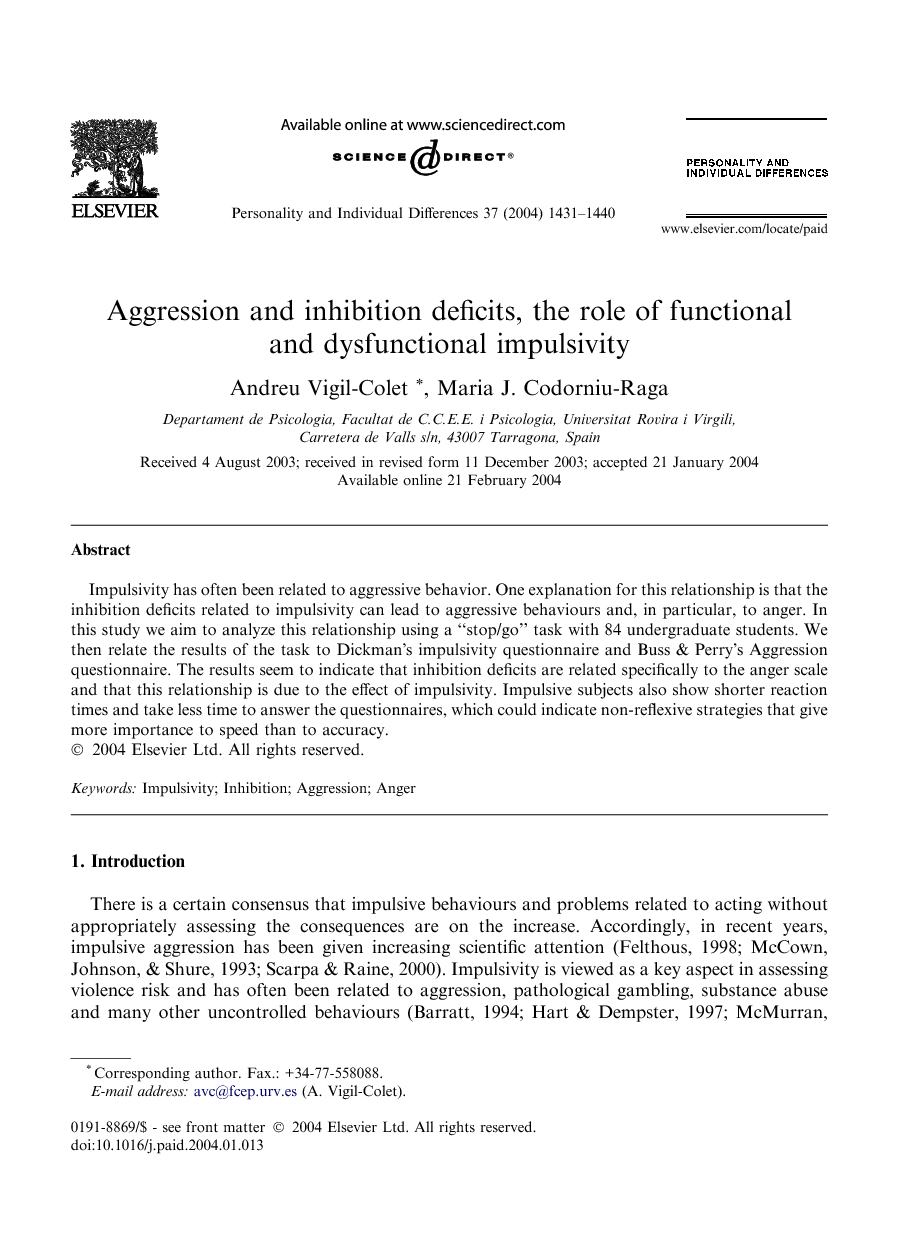پرخاشگری و مهار اختلالات، نقش تکانشگری عملکردی و نقص عملکردی
| کد مقاله | سال انتشار | تعداد صفحات مقاله انگلیسی |
|---|---|---|
| 33669 | 2004 | 10 صفحه PDF |

Publisher : Elsevier - Science Direct (الزویر - ساینس دایرکت)
Journal : Personality and Individual Differences, Volume 37, Issue 7, November 2004, Pages 1431–1440
چکیده انگلیسی
Impulsivity has often been related to aggressive behavior. One explanation for this relationship is that the inhibition deficits related to impulsivity can lead to aggressive behaviours and, in particular, to anger. In this study we aim to analyze this relationship using a “stop/go” task with 84 undergraduate students. We then relate the results of the task to Dickman’s impulsivity questionnaire and Buss & Perry’s Aggression questionnaire. The results seem to indicate that inhibition deficits are related specifically to the anger scale and that this relationship is due to the effect of impulsivity. Impulsive subjects also show shorter reaction times and take less time to answer the questionnaires, which could indicate non-reflexive strategies that give more importance to speed than to accuracy.
مقدمه انگلیسی
There is a certain consensus that impulsive behaviours and problems related to acting without appropriately assessing the consequences are on the increase. Accordingly, in recent years, impulsive aggression has been given increasing scientific attention (Felthous, 1998; McCown, Johnson, & Shure, 1993; Scarpa & Raine, 2000). Impulsivity is viewed as a key aspect in assessing violence risk and has often been related to aggression, pathological gambling, substance abuse and many other uncontrolled behaviours (Barratt, 1994; Hart & Dempster, 1997; McMurran, Blair, & Egan, 2002; Strauss & Mouradian, 1998). Moreover, some authors consider impulsivity as the best predictor of adult antisocial/delinquent disorders (Knorring & Ekselius, 1998; Tremblay, Pihl, Vitaro, & Dobkin, 1994). Barratt, 1991 and Barratt, 1994 focused on the relationships between impulsivity and aggression, differentiating between premeditated or learned aggression, medically-related aggression, and impulsive or spontaneous aggression. In a subsequent study, Barratt, Stanford, Dowdy, Liebman, and Kent (1999) used factor analysis to confirm the existence of the impulsive aggression and premeditated aggression constructs and their independence. Impulsive aggression is related to the impulsivity personality trait, characteristic of those who usually respond aggressively without thinking and often show guilt afterwards. Barratt (1991) defined them as individuals who have a tendency to “lose their temper easily” and are unable to control certain behaviours. Barratt (1991) considered that impulsive aggression is related to both the level of impulsiveness or impulse control, and the anger level of the individual. Three years later, he proposed a more specific explanation for this relationship. Barratt (1994) proposed that some people are predisposed to responding to certain stimuli or situations with feelings of anger that may lead to an aggressive response. If such a predisposition is combined with a high level of impulsivity, then the difficulty of inhibiting responses that is so characteristic of impulsives involves a low response control and this facilitates aggressive behaviour. From this viewpoint, impulsivity is related to situational control while anger is related to emotional drive. Nevertheless, results from cognitive and psychophysiological domains modified Barratt’s hypothesis by proposing that impulsiveness and anger are necessary but not sufficient in themselves for impulsive aggression, poor verbal information processing and social-problem skills and parietal lobe dysfunctions are also related to impulsive aggression (Barratt & Slaughter, 1998; Barratt, Stanford, Kent, & Felthous, 1997; McMurran et al., 2002). In 1990, Dickman developed a model of impulsivity that can help us to understand the relationships between impulsivity and aggression. He proposed that impulsivity may imply at least two distinct and independent forms. The first is functional impulsivity, which is related to a tendency to take quick decisions when this strategy is appropriate to the situation. The second is dysfunctional impulsivity and is related to speedy and non-reflexive decisions, which have negative consequences for the individual. This distinction is similar to Eysenck’s (1997) distinction between extraverted impulsivity and psychotic impulsivity, the former is the process of taking decisions with a calculated risk, while the latter is the process of taking decisions that do not take into account the associated risks and consequences of the action. From this viewpoint, Dickman (1990) developed an inventory to discriminate between these factors. Factorial analysis revealed two main factors that were related to functional and dysfunctional impulsivity. The final version of Dickman’s Impulsivity Inventory consisted of 23 binary items. A similar factorial pattern was found by Claes, Vertommen, and Braspenning (2000) in the Dutch version of Dickman’s inventory and by Caci, Nadalet, Baylé, Robert, and Boyer (2003) in the French version. Summarizing these results, Chico, Tous, Lorenzo-Seva, and Vigil-Colet (2003) found a high degree of congruence between the factorial structures of American, Dutch and Spanish adaptations of Dickman’s inventory. Impulsivity has also been related to the subject’s information processing style. Functional impulsivity has been related to a rapid information processing style when it brings positive consequence for the individual, while dysfunctional impulsivity seems to be related to the inability to inhibit competing responses. Moreover, dysfunctional individuals seem to spend less time considering their response (Brunas-Wagstaff, Bergquist, & Wagstaff, 1994). We have found that the consequences of these characteristics are the faster responses that impulsive individuals gave in personality questionnaires or their lower cognitive inhibition in some chronometric tasks (Ávila & Parcet, 1997; Moltó, Segarra, & Avila, 1992). Taking into account all these characteristics, dysfunctional impulsivity is viewed as the pathological component of impulsivity and may be responsible for the uncontrolled behaviours that are often related to impulsive aggression. The present study intends to analyze the relationship between inhibition deficits and aggression, and the role that impulsivity plays in this relationship. In this respect, we intend to show how impulsivity, and more specifically dysfunctional impulsivity, may be the responsible factor that explains the lack of inhibition so characteristic of individuals with high levels of anger.

